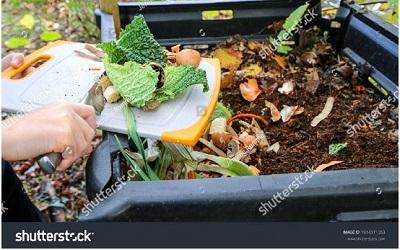
Composting Basics
Composting is the recycling by decomposition of kitchen and yard wastes and other organic materials combined in a specific manner into a wonderful soil amendment for the garden. For an overview and illustration of composting, watch this University of California webinar.
Home composting is most often done in an open pile or in a bin. The fast-acting, ideal pile is 3 feet by 3 feet by 3 feet, free-standing, dome shaped, or stacked in a rectangular container. Piles of smaller size are far more common but usually take longer to produce finished compost.
- Keep pile lightly covered to retain moist environment for microbes
- Turn and mix materials frequently
- Add water for even moisture as you build the pile
- Continue alternating materials
- Green garden debris, food wastes, manures
- More dry materials, shredded paper, carboard
- Green garden clippings, alfalfa, spoiled fruits
- Straw, dry leaves, coarse dry, brown material
Types of materials
Compost piles need materials containing both carbon and nitrogen to feed the insect and microbial decomposers. The most effective combination is a ratio of 30:1, C:N. In general, woody materials are high in carbon and referred to as "browns." Dry leaves, corn stalks, straw, bark, and wood shavings are good sources of carbon. Shredding or chipping these materials increases the surface area and makes decomposing easier for the microorganisms.
Nitrogen sources are often referred to as "greens." Grass clippings and fresh green prunings are good sources of nitrogen. Others are kitchen scraps and animal manures, including cow, horse, and poultry wastes (not from dogs, cats, or humans). Avoid meats, bones, and excessive fats in kitchen scraps. You can see from the table below that it takes fewer nitrogen "greens" and more carbon "browns" to achieve the desired combination.
If your compost mix is too low in nitrogen, it will not heat up and will need additional nitrogen-rich materials. If the nitrogen proportion is too high, the compost may become too hot, killing the microorganisms, and will need some carbon-rich materials to be added. The pile also may become anaerobic, lacking oxygen, resulting in a foul-smelling mess.
The carbon:nitrogen ratio does not have to be exact. You can calculate the C:N ratio of your compost mixture, or you can estimate optimal conditions simply by using a combination of materials that are high in carbon and others that are high in nitrogen. A rule of thumb is that two to three volumes of browns be mixed with one volume of greens in order to produce a mix with the correct C:N ratio for composting.
C:N Ratios of Some Common Compost Materials
| Material | C:N | Material | C:N |
| Bark | 120:1 | Paper | 170:1 |
| Coffee Grounds | 20:1 | Poultry Dung | 10:1 |
| Cow Manure | 20:1 | Sawdust | 500:1 |
| Grass Clippings | 20:1 | Straw | 40-100:1 |
| Horse Dung | 25:1 | Vegetable Scraps | 12-20:1 |
| Dry Leaves | 60:1 | Wood Shavings | 100-500:1 |

Simple but important rules
The composting process is actually a highly complicated chemical and biological process, but you don't need to understand all the details for it to work. The simplest method is to build the pile and let it sit for six months to a year, after which the compost will be ready. To shorten that time and create compost much faster, you can build a 3 ft. x 3 ft. x 3 ft. fast-acting pile.
- The pile (freestanding or in a bin) is made by alternating green and brown layers—about 4 inches of green materials with about 8-10 inches of brown materials, starting with a brown layer on the bottom.
- Each layer needs to be well watered as it is added to achieve a roughly 50% water content. A simple test is to squeeze a handful after watering. If it falls apart, it's too dry; if it oozes a lot of water, it's too wet. With correct moisture, the handful will easily hold together. It will take more water than you think to achieve this, not just a light sprinkle.
- The decomposition process generates heat, CO2, and water vapor, and the pile has to reach an internal temperature of 120-130 degrees to work well. With the correct C:N balance, size and water content, a pile will reach a working temperature in 1-2 days. A digital thermometer duct-taped to a stick is helpful.
- The compost pile must not get too hot—not above 160 degrees—or the microorganisms die. To prevent this, the pile needs to be turned periodically. The longer the interval between turning, the longer it takes for composting to finish. A standard pile turned weekly will take 6-8 weeks to complete. A rapid compost pile, turned daily, will complete in about 2 weeks. Turned every other day, it takes about three weeks. Turning means thoroughly inverting the pile—inside to outside, top to bottom—with a pitchfork.
The completed compost pile will be much smaller, and the compost much finer than at the beginning. Some people screen their compost to remove remaining large pieces, but that's not mandatory. Allow the finished material to rest a few days or weeks, then use it in your garden.
January 2023







